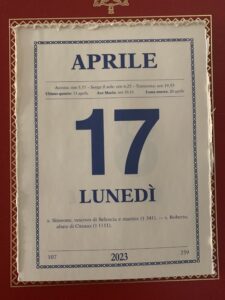 Roma sun-up 0625
Roma sun-up 0625
Roma sun-down 1955
Ave Maria 2015
You have to enjoy the many images of Our Lady in Rome, every couple of streets, each little neighborhood had theirs. And you often see votive offerings, silver hearts, have been affixed out of gratitude for a favor granted.
If you don’t ask for favors, you won’t get them. If you don’t ask for miracles, you won’t get them.
Back in the day, people asked and asked and asked because they believed and believed and believed.
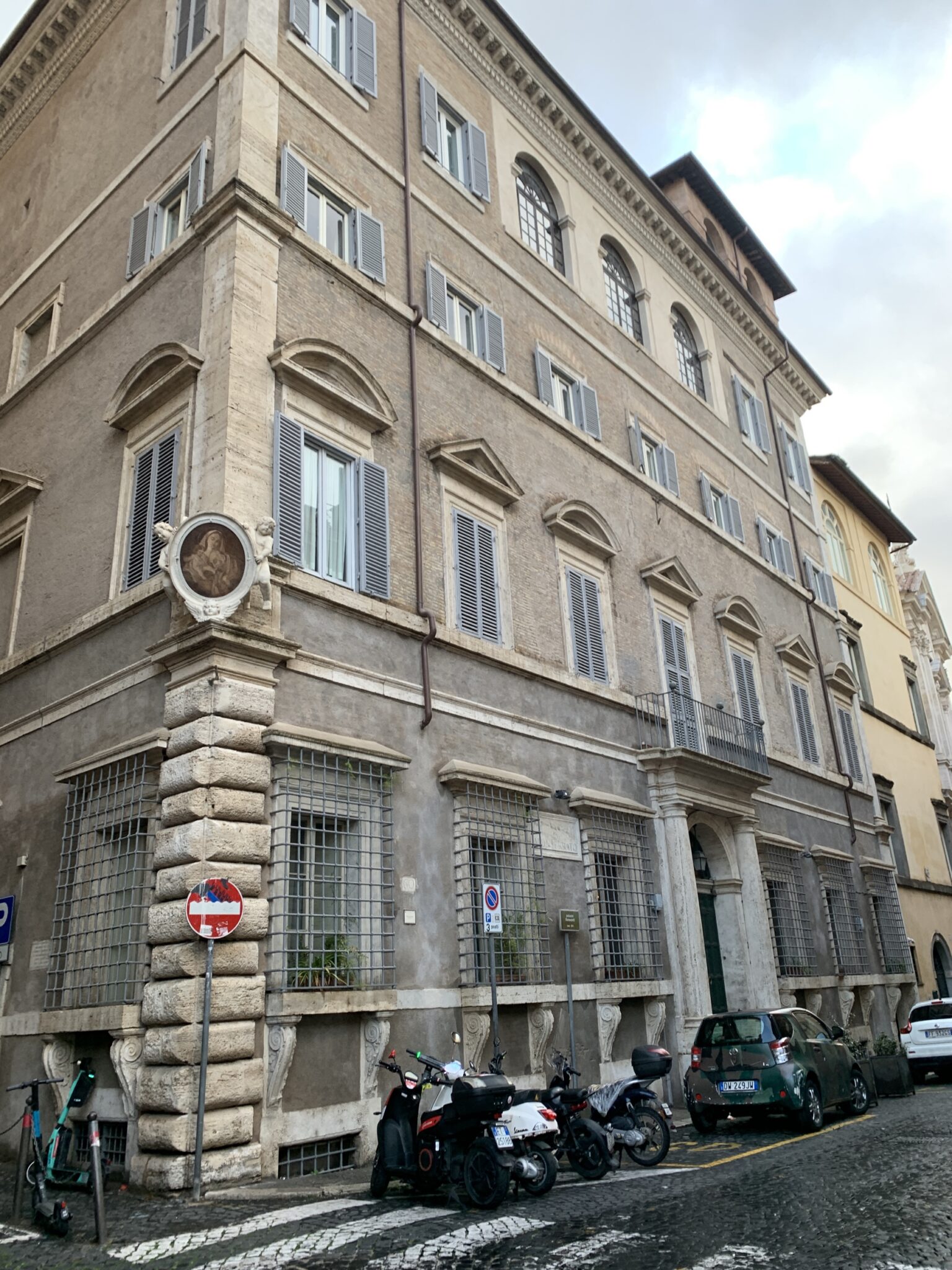
This particular image of Mary doesn’t have a votive offering, but St Pippo, co-patron of Rome is kissing Baby Jesus little toe, which is kinda the same thing donchya think?
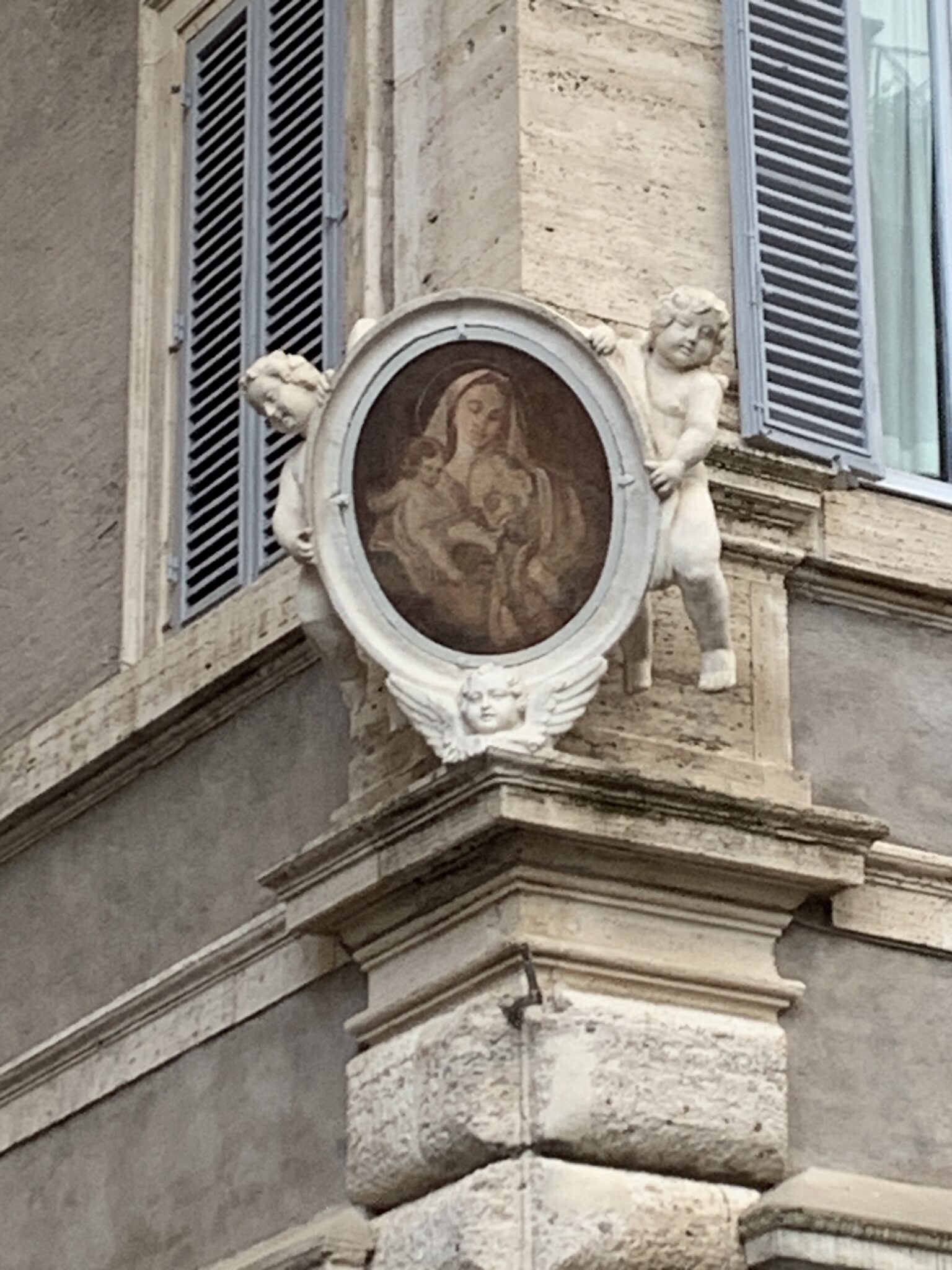
I think Baby Jesus and the putti hanging onto the frame have the same barber.
Here’s an action shot from yesterday. The paschal candle is tall enough that it is hard to light and put out from below. The enterprising sacristan found a different angle while putting out the “big six”. Kudos.
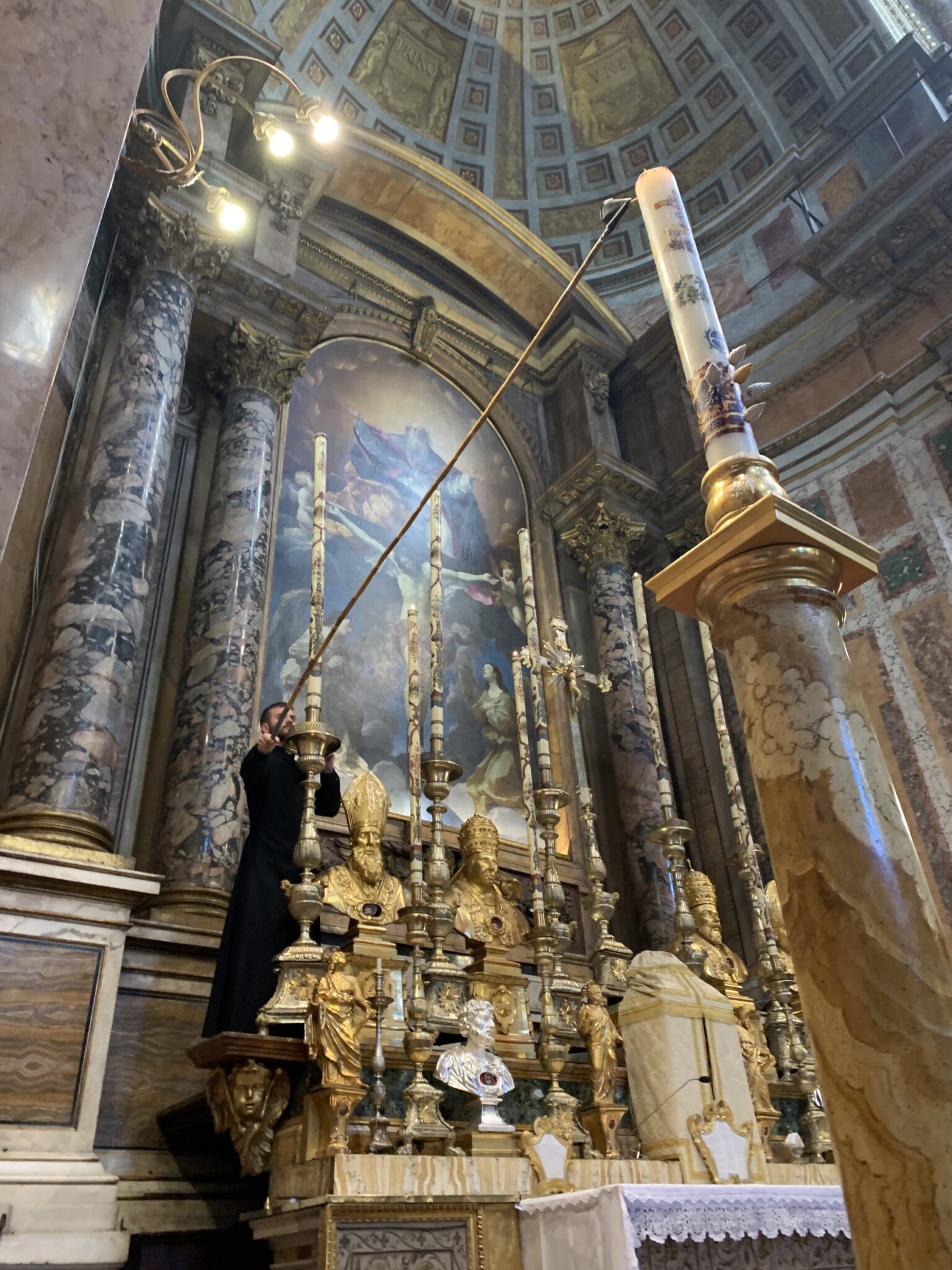
 Meanwhile… I remind you of Fr. Claude Barthe’s book, now in English, A Forest of Symbols: The Traditional Mass and Its Meaning. US HERE – UK HERE
Meanwhile… I remind you of Fr. Claude Barthe’s book, now in English, A Forest of Symbols: The Traditional Mass and Its Meaning. US HERE – UK HERE
Here is another little tease. Always remember that Mass is not a “didactic moment”. Even though there are moments that are “didactic”, they are not primarily so. They are acts of sacrifice, glorification, praise and supplication. Even the readings are sacrificial. That is why in the Vetus Ordo the priest must read them even when they are sung by the sacred ministers. Christ the High Priest, the Word, is raising Himself to the Father in the flowing sounds of human language, Word incarnated raised as a glorification, a petition to be heard, oblation by His Priesthood, a fleeting sacrifice.
With that in mind, here is Fr. Barthe:
First, at the altar, on his knees on the highest step of the altar on which he has placed the Gospel book, he asks God for a purification similar to that undergone by Isaiah in the Temple at his calling (Is 6:6–7): Munda cor meum ac labia mea. . . (Cleanse my heart and my lips, O God almighty, who didst cleanse the lips of the prophet Isaias with a live coal: vouchsafe, of thy gracious mercy, so to cleanse me, that I may worthily proclaim thy holy Gospel). [This is the pattern! We purify and then we bless. We exorcise water before we bless it, etc.]
Then, in front of the celebrant, the deacon, holding the Gospel book against his breast, comes to ask the blessing of the celebrant (Pray, sir, a blessing. The Lord be in thy heart, and on thy lips . . . ). After the deacon has been blessed by the celebrant, the celebrant places his right hand on the Gospel book and presents it to the deacon to be kissed as an indication that Christ confers his power and his virtue on his apostles, giving them the gifts of his spirit that flow out from him, especially from his hand, the source of good works. Christ passes on to him in particular the gifts of languages, of speech, and of the voice, with the hand of the celebrant touching the purified mouth of the deacon and the purified mouth of the deacon kissing the consecrated hand of the celebrant. From then on, the Lord’s right hand passes on his Spirit, which alone can give an understanding of the mysteries, uncovering what is hidden within them, can give the grace necessary to talk of them, and can communicate the power to make them heard. This kiss is a kiss of respect, but it is even more designed to plumb the depths of the divine force of Jesus Christ’s holy humanity, and in particular the force of his humano-divine speech.
Meanwhile,…
White to move.
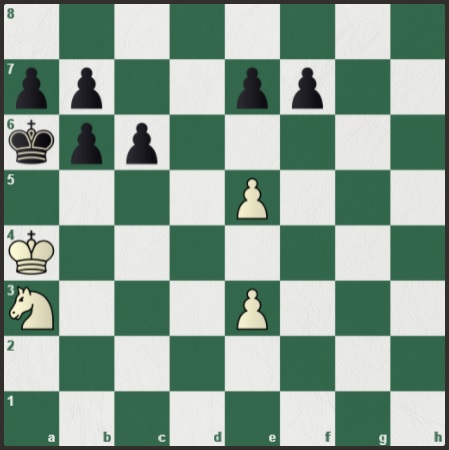
NB: I’ll hold comments with solutions ’till the next day so there won’t be “spoilers” for others.
Your use of my Amazon affiliate link is a major part of my income. It helps to pay for insurance, groceries, everything. Please remember me when shopping online. Thanks in advance. US HERE – UK HERE
Game 6 between Ding and Nepo was really something. Ding played the LONDON and Nepo played … not so well, all in all, and got into trouble. But at this level you can get out of trouble if given a tiny advantage. It was not to be for Nepo, however, because Ding Liren played a forcing mating net that was a thing of exquisite beauty. It was breathtaking.
Here is the video of the coverage which I bookmarked at the point where Ding is closing in for the kill and the commentators are looking to find it before Ding plays it. Anish had his good plan, but what Ding Liren does is amazing. Give it a try with a little patience while the pressure builds up to Ding’s initially puzzling but super-crafty move. As we join, Ding is having a think. Note also Anish’s insightful comments about how different players calculate.
You would really enjoy this will a glass of beer from Norcia. Believe me. Some savory sausage and a sharp cheese. Great beer made by traditional Benedictines building their new monastery from the beer you then enjoy while reading Fr. Z’s blog and doing chess puzzles? Does it get better than that?


































If I speak in the tongues of men and of angels, but have not love, I am only a resounding gong or a clanging cymbal. 1 Corinthians 13 1
“If you don’t ask for favors, you won’t get them. If you don’t ask for miracles, you won’t get them.” A timely and much needed reminder.
Thank you for the photos of Rome and the “action shots.” I look forward to them every day.
As much as I don’t want to be called all sorts of nasty names in this forum …
I think this line is stretching things a bit:
“Even the readings are sacrificial. That is why in the Vetus Ordo the priest must read them even when they are sung by the sacred ministers.”
I’m inclined to agree with Dom Gueranger here – perhaps we read too much into the aspects of the Usus Antiquor specific to the “Low Mass” (sung or otherwise). The (Pontifical) Missa Solemnis (Solemn High Mass) IS the actual form of the Usus Antiquor, albeit the least often seen manifestation of it:
“We shall never have anything like a full idea of the ceremonies of the Mass, unless we keep referring to what is called a High Mass, (Missa Solemnis), and which is the type of all others. Thus, one would ask, why does the Priest say the Epistle at one side of the Altar, and the Gospel at the other? why not read both from the middle? This has no connection with the Holy Sacrifice itself; it is merely an imitation of what is done in a High Mass, in which the Deacon has to sing the Gospel on the left, and the Sub-deacon the Epistle on the right.”
[What you cite doesn’t contradict what I wrote. And the side of the altar used also is not relevant: it’s still at the altar. Moreover, even if the Bishop reads the readings at the throne instead of at the altar, he is nevertheless the PRIEST reading them. Moreover, here is some homework for you. Take a look at the RITUS SERVANDUS in the 1962MR and, say, the 1911 printing. You don’t have to read the whole thing. Just take in how they are presented. Once you’ve done that you might think the implications for a bit and then get back. A little side project for your copious free time.]
While that may be true, it is notable that the bishop (at a Pontifical Solemn High Mass – arguably the ‘normal form’ of the Vetus Ordo) does not read the parts of the Mass of the Catechumens which are sung by the deacon and subdeacon (at least according to Fortescue, O’Connell, et al). 1911 would be a sample of where things were at during Pius X’s reign, but I’m not sure that’d be a good basis for figuring just how it happened (historically) that the priest came to recite the readings while the deacon and subdeacon were already singing them. That historical context is, I would argue, critical for understanding the action’s significance (and if a connection with the sacerdotal office is warranted as you suggest – especially given that the Mass of the Catechumens was, at one point in antiquity, a distinct liturgy separate from the Mass of the Faithful – perhaps an old synaxis?).
Interesting about the significance of the kissing of the hands. I had never thought about that before.
“This has no connection with the Holy Sacrifice itself; it is merely an imitation of what is done in a High Mass, in which the Deacon has to sing the Gospel on the left, and the Sub-deacon the Epistle on the right.”
I disagree, and the venerable Gueranger ought to no better:
1)The Epistle is read to the assembly present, because it is an epistle, and when it was originally sent it would have been read to the assembly. This usage is continued. Thd Gospel, however, is preached to the north, because that’s where the heathens are, that’s mission territory. (How little changes) It’s not “just because,” and that is, because…
2) The passage cited doesn’t give a proper account of the formal causality. It’s tautological to say that a foal trots because adult horses trot. That’s not a causal explanation. The reason why this is done in a Low Mass is the Same as it is done in a High Mass. And this reason, I would argue, compasses the sacrificial aspect. That moderns can’t grasp how a seemingly didactic act can actually and primarily be a sacrificial act is one of the delusions that comes with the disease of modernity.
@diaconus_in_urbe
“especially given that the Mass of the Catechumens was, at one point in antiquity, a distinct liturgy separate from the Mass of the Faithful – perhaps an old synaxis?).”
I’m genuinely curious: is this something we have clear written evidence of, or is it a conjecture?
There’s only one thing I trust less than the conjecture of a biblical historian, and that is the conjecture of a liturgist.
Peter Kwasniewski has a review of the new English translation of “A Forest of Symbols”.
Vindicating the Allegorical Interpretation of the Mass: Abbé Claude Barthe’s “Forest of Symbols” Finally in English
Excerpt:
This book has one and only one purpose: to explain, defend, and carry out the allegorical interpretation of the Mass. As Fr. Barthe points out, for over a thousand years, the Roman Mass was approached as a “forest of symbols,” to use an evocative phrase from Baudelaire. Every part of the rite, every ceremony, down to the smallest sign of the cross or movement from left to right or incensation pattern, was eagerly mined for meaning. Yes, one might say these meanings were sometimes imposed by the religious imagination, but one could also defensibly say they were discovered, elicited from the rite itself, due to the extreme ease or naturalness with which our forefathers saw spiritual meanings in all kinds of things, especially in Scripture. They extracted the full juice of the grape and allowed it to mature into rich wine.
I think Dom Gueranger’s point was the Low Mass merely mimics the full expression of the Vetus Ordo in the Missa Solemnis. Hence, the priest reads the readings at either end approximating what the subdeacon and the deacon actually do (when present). Dom Gueranger seems to be making a point about the Missa Solemnis which was taken for granted in the High Middle Ages.
Apparently, the priest just started reading what the deacon and subdeacon were already doing, due to an increase in the use of the Missa lecta between 1260 and 1502 catalyzed by the Franciscan ‘private Mass’ instruction called the ‘Indutus planeta.’ By the 1502 appearance of the Ritus Servandus, the Missa Solemnis had apparently shifted to be treated like the ‘nice add-on’ to the now-normative Missa lecta. It doesn’t appear to be theologically motivated, but rather motivated by the fact that the ‘private Mass’ outlined by the Indutus planeta was simply easier-to-do in smaller chapels outside of urban centers, since they needed fewer books, and fewer sacred ministers (kind the same motivation for a lot of priests these days who choose Eucharistic Prayer II over the Roman Canon in the Ordinary form – while it gets the job done, it DOES require less time and effort, albeit with a loss of some theological depth and ceremony). In a similar manner, Eucharistic Prayer II is currently replacing the Roman Canon as the de facto ‘normative Canon’ in practice in the Ordinary Form.
For reference point: the Missa Solemnis was apparently normative in Thomas Aquinas’ day in the 1200’s, as suggested by his outline of the Mass in ST III Q.83 Art. 4, though he certainly notes ‘private Masses’ are are just fine, too.
The medieval Christian certainly had no issue with the sacrificial understanding of the Mass (c.f. ST III Q. 83), nor did they did think it necessary that the priest read the Epistle and the Gospel when the subdeacon and deacon were already singing them, either. So, coming full circle – it seems that seeing some kind of ‘offering’ of the epistle and Gospel by the priest, simply because he (or the bishop-as-priest) reads them seems to be stretching things a bit.
“Apparently, the priest just started reading what the deacon and subdeacon were already doing, due to an increase in the use of the Missa lecta between 1260 and 1502”
Granted, but your interpretation of this is that they started to do the readings “just because” that’s the way it was done in a private Mass.
One could argue that the increase in usage of private Masses, especially among monastic clergy, catalysed a deeper understanding of the sacrificial understanding of the Mass, one of the outcomes of this being the incorporation of the readings being done additionally by the celebrant.
@TheCavalierHatherly – as far as a complete ‘Roman Missal,’ outlining things in detail (with rubrics) like we’ve had since the 13th century onwards – no. We don’t have anything resembling rituals in that detail earlier than the Leonine/Verona Sacramentary of the 6th century (which contains the proper prayers for Mass, ordinations, the blessing of consecrated virgins, etc. with few – if any – rubrics).
We do, however, have Egeria’s Itinerary from 384 A.D. which gives a rather detailed look at Holy Week in the Church in Jerusalem, where we see the distinction between the Synaxis and the Eucharistic liturgy, proper. Eastern Churches still observe a modest set of the distinct synaxes to this day (though significantly fewer). We see the only remaining specifically Roman instance of this in the Missa Præsanctificatorum i.e. the Good Friday liturgy (interestingly, also the only place the ‘bidding prayers’ were preserved in the full Roman format before being reduced to that odd, dangling, “Dominus vobiscum,…. Oremus,” – with nothing afterwards- right before the Offertory in the Vetus Ordo).
Nonetheless, we see multiple examples of the Roman version of the synaxes in the details of the papal rites in the various editions of the Ordines Romani (appearing from the 7th century onwards).
Also, the names ‘Missa Catechumenorum’ and ‘Missa Fidelium’ do come from dismissing (dis-missa-l) of both of these groups of people in the ancient Church by the deacon (an act STILL preserved in the Byzantine Divine Liturgy, where the deacon says, “The Doors! The Doors!”). This use of the phrase ‘missa catechumenorum’ is seen in St. Augustine’s and St. Ambrose’s writings (i.e. referring to the act of dismissing the catechumens – and not to a part of a combined liturgy).
All this serious discussion in the comments, and here I am just trying to figure out what to do with the knight in that chess puzzle.
@TheCavalierHatherly
“One could argue that the increase in usage of private Masses, especially among monastic clergy, catalysed a deeper understanding of the sacrificial understanding of the Mass, one of the outcomes of this being the incorporation of the readings being done additionally by the celebrant.”
The monastery most definitely had a part in this. As In understand, a lot of monks were promoted to priests as the understanding that a Mass was offered FOR some particular purpose/person grew (and Masses needed to be said for those intentions, as well as more priests were needed for the evangelization of Europe at the time). Nonetheless, St. Thomas Aquinas’ ST III Q.83 (Art 4) doesn’t seem to entertain any notion of the readings as part of the sacrifice of the Mass in his take on it in the 13th century – he pretty much just leaves the readings at the level of ‘instruction:’
“So then, after the people have been prepared and instructed, the next step is to proceed to the celebration of the mystery, which is both offered as a sacrifice, and consecrated and received as a sacrament: since first we have the oblation; then the consecration of the matter offered; and thirdly, its reception.”
N.b. he doesn’t refer to anything before the oblation as a sacrifice.
Given ST Supp. Q. 37 Art. 4 Ad.3, the medievals probably just figured the priest could supply what was properly the deacon’s and subdeacon’s functions, since the lower orders were figured to be contained in the higher ones. Furthermore, since offering the sacrifice was proper to the priest, but the readings proper to the lower orders, the medievals would probably have rejected a notion of the readings being ‘sacrificed,’ since a deacon and subdeacon (properly, in the medieval understanding) read the readings, and could not do what was proper to the priesthood (i.e. offer sacrifice), since they (deacons and subdeacons) were of a lower order.